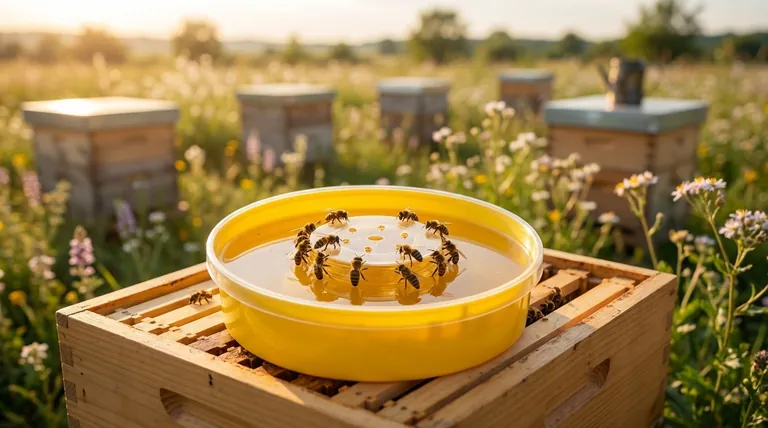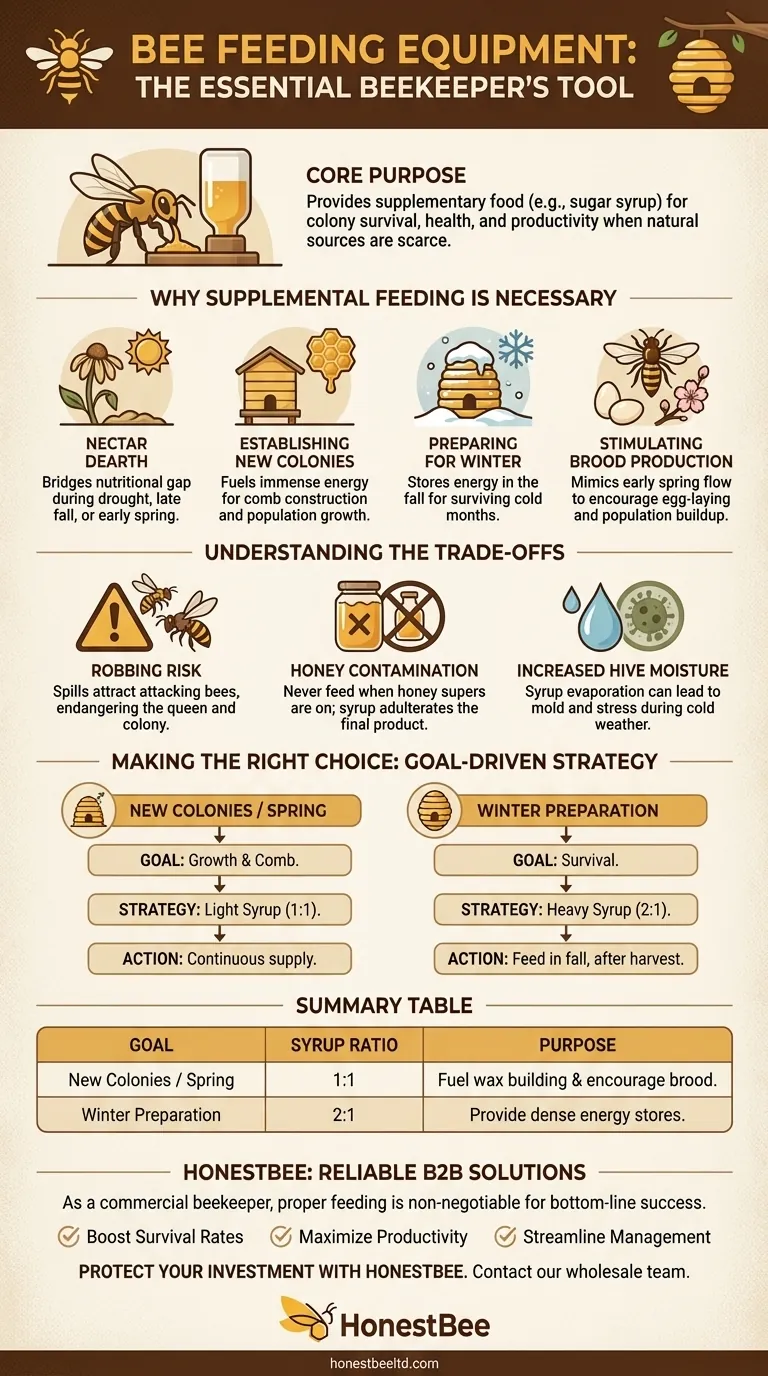Bee feeding equipment serves a single, critical purpose: it is used to provide honeybee colonies with supplementary food, most often sugar syrup, when they are unable to gather enough natural nectar on their own. This intervention is a fundamental tool for beekeepers to ensure the health, survival, and productivity of their hives during vulnerable periods.
A honeybee colony is a finely tuned natural engine, but it isn't invincible. Bee feeding equipment is the beekeeper's tool to provide essential fuel when the colony's natural supply lines are cut off by weather, season, or circumstance.

Why Supplemental Feeding is Necessary
While bees are remarkably self-sufficient, modern beekeeping and environmental pressures often create situations where a colony cannot sustain itself. Feeding becomes a necessary management practice to ensure survival and strength.
Overcoming Nectar Dearth
A nectar dearth is any period when there are few or no nectar-producing flowers blooming. This can happen during a summer drought, in late fall, or in very early spring. Feeding bridges this nutritional gap, preventing the colony from starving or shrinking.
Establishing New Colonies
A newly installed package of bees or a small nucleus hive has no stored honey. They must be fed consistently to provide the immense energy required to build wax comb, which serves as the nursery for new bees and the pantry for all food stores.
Preparing for Winter
If a colony has not stored enough honey to survive the long, cold winter months, supplemental feeding in the fall can be the difference between life and death. A heavier syrup helps them store the energy they will need to cluster and generate heat.
Stimulating Brood Production
In early spring, a light syrup feeding can mimic the first nectar flow of the season. This signals to the queen that resources are plentiful, encouraging her to begin laying eggs and build up the hive's population in preparation for the main honey flow.
Understanding the Trade-offs
Feeding is a powerful tool, but it is not without risks. Improper feeding can create more problems than it solves, and it is a responsibility that must be taken seriously.
The Risk of Robbing
Spilled syrup or poorly designed feeders can attract bees from other, stronger hives. This can incite robbing, where the intruder bees attack the hive to steal its resources, often resulting in the death of the weaker colony's queen and bees.
Potential for Honey Contamination
Never feed a colony sugar syrup when honey supers (the boxes meant for human consumption) are on the hive. The bees will store this syrup alongside nectar, adulterating the final honey product. Responsible beekeepers only feed when they are not also collecting honey.
Increased Hive Moisture
Processing large amounts of sugar syrup requires the bees to evaporate significant water content. This can lead to excessive moisture inside the hive, which can promote mold and stress the colony, particularly during cold weather.
Making the Right Choice for Your Goal
Using feeding equipment effectively requires a clear understanding of your purpose. The goal dictates the strategy.
- If your primary focus is establishing a new colony: Provide a continuous supply of light (1:1 sugar-to-water) syrup to fuel comb construction and population growth.
- If your primary focus is preparing for winter: Feed a heavy (2:1 sugar-to-water) syrup in the fall after you have removed any honey you plan to harvest.
- If your primary focus is stimulating spring growth: Use a light (1:1) syrup in early spring to encourage the queen to lay, but stop as soon as natural nectar becomes available.
Mastering the use of feeding equipment is a key skill that allows a beekeeper to proactively support their colonies through their most challenging times.
Summary Table:
| Feeding Goal | Syrup Ratio (Sugar:Water) | Key Purpose |
|---|---|---|
| Establishing New Colonies / Spring Stimulation | 1:1 | Fuel wax comb building and encourage brood production. |
| Winter Preparation | 2:1 | Provide dense energy stores for surviving cold months. |
Ensure your apiary thrives through every season with reliable feeding equipment from HONESTBEE.
As a commercial beekeeper or distributor, you understand that colony health directly impacts your bottom line. Proper feeding is non-negotiable for maintaining strong, productive hives. HONESTBEE supplies durable, efficient feeding solutions designed for the demands of large-scale operations, helping you:
- Boost Survival Rates: Prevent colony loss during critical periods like winter and nectar dearth.
- Maximize Productivity: Stimulate population growth to capitalize on honey flows.
- Streamline Management: Use equipment built for efficiency and reliability.
Let us help you protect your investment. Contact our wholesale team today to discuss your apiary's needs.
Visual Guide

Related Products
- HONESTBEE Round Hive Top Bee Feeder for Syrup
- Rapid Bee Feeder White Plastic 2L Round Top Feeder for 8 or 10-Frame Bee Hives
- HONESTBEE Entrance Bee Feeder Professional Hive Nutrition Solution for Beekeeping
- Professional Hive Top Bee Feeder for Beekeeping
- Classic Boardman Entrance Bee Feeder Hive Front Feeding Solution
People Also Ask
- How should syrup for bees be prepared? Master the Ratio for a Thriving Hive
- What features make top feeders a reliable choice for beekeepers? A Guide to Safe, Efficient Hive Nutrition
- What can the round hive top feeder be used for? A Guide to Efficient, Safe Bee Feeding
- How do you set up and use a top feeder for bees? A Step-by-Step Guide for Safe Feeding
- How do hive top feeders work? A Guide to Efficient, High-Capacity Bee Feeding



















